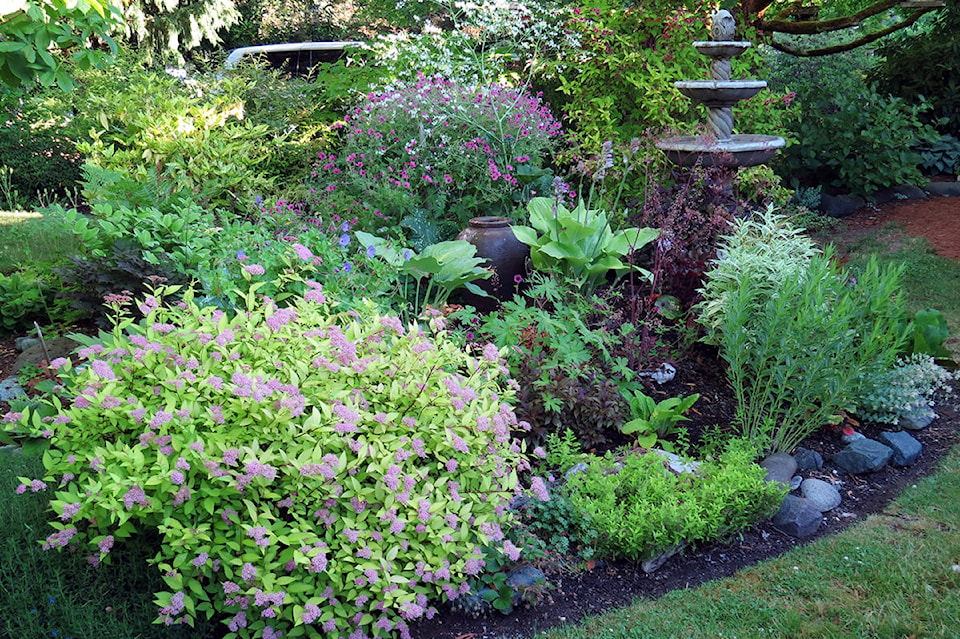Leslie Cox
Special to The Record
Feast and famine. It is decidedly a feast for the birds; robins, evening grosbeaks, cedar waxwings, and a host of other species. The branches on our serviceberry tree, Amelanchier x grandiflora ‘Princess Diana’, are positively dancing as the birds alight to feed on the ripening berries.
Meanwhile, I feel very fortunate I was able to pick my two cups worth of berries in order to make a cobbler. With the tree loaded in berries this year, my measly pickings definitely fall on the famine side.
Amelanchier has more common names than there are days in the week: shadberry, shadbush, Juneberry, prairie berry, pigeon berry, Saskatoon berry, sarvisberry, sugar plum, sugar pear, Indian pear…and the list goes on. However you want to call it, this is definitely a plant worth growing.
Fifteen of the 20 species in this genus are native to North America. Most grow 13 – 20 feet tall, making them useful as understory plants against tall trees. They are tolerant of most soil conditions and are happy in either full sun or filtered shade. Masses of delicately petalled, white flowers adorn the multi-stemmed plants in early spring, providing the earliest pollinators with a valuable food source at a critical time. And as I mentioned, the small fruits start to ripen in June… at least on our Amelanchier x grandiflora. Apparently, Amelanchier alnifolia fruits ripen in August, so there is likely a range of harvest dates amongst the different species. (Amelanchier alnifolia is native to the Pacific Northwest.)
Interestingly, the small, purple-red fruits are more correctly called a “pome.” Their seeds are wrapped in a thin, paper-like casing like those in apples, rather than embedded in the flesh like a grape. And they are delicious, albeit slightly seedy.
Good for you too. Nutritionally, they have more calories, protein, carbohydrates, fibre, vitamin C, iron, and potassium than blueberries, raspberries, and strawberries. Their colour also tells us they are high in anthocyanins - those healthy flavonoid compounds that are beneficial against chronic diseases, such as cancer and heart disease.
The fruits can be used in most recipes that call for blueberries and currants. These include: muffins, scones, bread, cakes, pies, tarts, jams, sauces, wine, cider, and liquors. They can also be dried. (You can find my Serviceberry Cobbler recipe on my website: duchessofdirt.ca.)
Speaking of feast… our garden is rich in flowers this year. John has proclaimed 2018 as the Year of the Flowers. Definitely, the bees are happy. Not to sound corny, but the garden is quite literally buzzing with a myriad of bee species. My winter project will be to try and identify them all.
Amongst some of the flowering plants worth mentioning are the hardy geraniums. I have talked about this perennial plant genus in past columns but they merit exposure again. At the top of the “plus list” is their drought tolerance, as well as pest and disease resistance. We have yet to find any problems on any of the over 40 different species and cultivars we have in our garden. Quite a remarkable feat when you think of the problems occurring on other plants.
Of particular note, I can highly recommend Geranium psilostemon, also known as American cranesbill. Provide this one with a peony ring to support its tendency to flop and ramble along the ground and you will be rewarded with a three by three foot display of magenta flowers accented with a deep purple throat.
Other geraniums of note, in no particular order, include: G. renardii, G. sanguineum, G. pratense, and G. x ‘Johnson’s Blue.’
Oh, hey. I have just learned amelanchier berries will continue to ripen after picking! Just like apples. Where’s my harvest basket? I see more cobblers and muffins in our future.
Leslie Cox co-owns Growing Concern Cottage Garden in Black Creek. Her website is at www.duchessofdirt.ca and her column appears every second Thursday in the Record.
